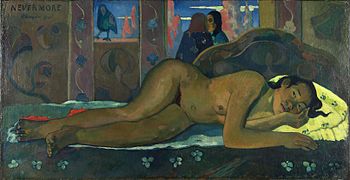Nevermore (Gauguin)
Nevermore is an 1897 oil on canvas painting by the French Post-Impressionist artist Paul Gauguin. Since 1932 it has been in the collection of the Courtauld Institute of Art and on display in the Gallery. It was executed during the artist's second stay on the island of Tahiti in the South Pacific.
| Nevermore | |
|---|---|
| O Taiti | |
 | |
| Artist | Paul Gauguin |
| Year | 1897 |
| Medium | Oil on canvas |
| Dimensions | 96 by 130 centimetres (38 in × 51 in) |
| Location | Courtauld Gallery, London |
The enigmatic work depicts a naked Pahura, Gauguin's teenage vahine or wife, lying on a bed in their hut, her voluptuous figure echoed by the curves of the headboard. In the background behind the bed can be seen a raven and two mysterious human figures. [1]
The title "Nevermore", painted in relatively large capitals in the top left-hand corner, and the presence of the raven is an obvious reference to Edgar Allan Poe's poem "The Raven", which was well known to Gauguin and recited at his farewell party in 1891. In the poem a mourning student is visited in his room by a raven which croaks the one word "nevermore" in response to his every question. At the time the painting was executed Pahura was grieving the loss of her first child (by Gauguin) and Gauguin the loss of his favourite European-born daughter Aline. The artist himself claimed the bird represented a "bird of the devil who watches". [2]
The painting was purchased in 1898 by the British composer Frederick Delius from Gauguin's friend George-Daniel de Monfreid for 500 francs. It was later bought by the British businessman Samuel Courtauld in 1926, who gifted it to the Courtauld Institute of Art.
In 2010, the painting was voted Britain’s most romantic in a poll organised by the Art Fund Charity. It beat competition from a 5 painting shortlist, which included masterpieces by Jan van Eyck and Titian. [3]
References
- "Nevermore, 1897". gauguin.org. Retrieved 7 January 2020.
- "Nevermore – Paul Gauguin". Courtauld Institute. Retrieved 7 January 2020.
- Telegraph.co.uk/culture